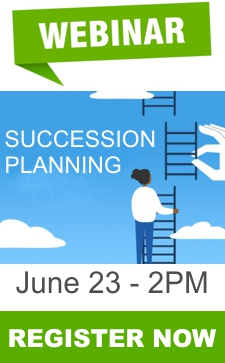
Issue 219 - June 2021
This month's issue of Harvard Business Review features an article on how to "Eliminate Strategic Overload." Harvard Business School professor, Felix Oberholzer-Gee shows "how to select fewer initiatives with greater impact." He concludes, "creating value for customers, employees, and suppliers sits at the very heart of strategies that result in stellar performance. In the best companies, this orientation toward value creation is reflected in every decision made by employees at all levels of the organization. The focus on creating value shows up in big strategic decisions and in small everyday choices."
However... "The strategic insight is simple; implementing it requires discipline." He outlines a few key patterns from his "research work with organizations that exemplify value-based strategy:"
- They focus on value, not profit
- They attract the employees and customers whom they serve best
- They create value for customers, employees, or suppliers (or some combination) simultaneously
- They pursue complements (products/services enhancing their core offering) as a rich source of value creation
- They shift profit pools to capture value over time.
The article is useful as far as it goes, but it doesn't go far enough. Oberholzer-Gee's glaring gap is failing to connect his value-based strategies to leadership and organizational culture. We've long seen -- and a growing body of research shows -- the Purpose-Profit Paradox. Profit is a means, not an end. Fewer people today want to buy from, work for, or partner with a company that's only out for itself. Thriving companies pursue both purposeful profits and profitable purpose. Pursuing profits without a higher purpose or pursuing a purpose without profit are both fatal strategies.
This issue looks at a few aspects of organizational culture. My podcast with BreAnne Okoren starts with a broad look at leadership and then focuses on five steps we've found can most effectively shift organizational culture.
We also look at a vital leadership and culture issue of our time: COVID fatigue. Some organizational cultures are creating thriving workplaces during these challenging times. Others...not so much. We'll learn from key insights in Michelle McQuaid's recent research on workplace wellbeing and her new report on a Canadian survey comparing her findings to previous American and Australian studies.
An especially exciting medical breakthrough of our pandemic is the messenger RNA (mRNA) technology now used in Moderna and Pfizer-BioNTech vaccines. We'll get five key elements of outstanding leadership and culture effectiveness directly from the Pfizer CEO based on their success.
I hope you find this is a value-based issue that's worth far more than you're paying for it!
Podcast: 5 Steps to Shift Your Company Culture

What are key leadership trends of the past year? How's leadership different in Canada? How can a culture be changed? What are the greatest leadership lessons of my career? These are a few of the simple and easy questions BreAnne Okoren asked me in a recent podcast...
Right….all quick, easy, and simple issues! BreAnne and I skipped over a few of these massive icebergs as we touched briefly on these huge topic areas in a 17-minute podcast. In 5 Steps to Shift Your Company Culture, we discussed:
- Leadership trends emerging from our very difficult past year
- Differences in Canadian approaches to leadership. I think I saw a moose...
- Drawing from my recent, ahem, blog, Is Your Team Coughing Up a Cultural Hairball?, we discussed these five key steps to shifting culture:
- Assess current systems, practices, culture, and readiness for change
- Leadership team planning strategy session
- Realign/integrate/prune current projects, processes, systems, and development initiatives
- Plan implementation strategies and timeliness
- Monitor, follow up, and adjust implementation plans
- Approaches to building a safety culture with mining companies that caused fatalities and injuries to drop by over 60%
- The three key questions at the core of personal, team, and organizational leadership
- How my interest in positive psychology and how strength-building led me to Zenger Folkman
- One of my favorite quotes on leadership
Of course, quick and easy don't belong in the same sentence as boosting leadership and culture effectiveness. After decades of research and seeing what works and what doesn't, there are a few timeless leadership principles capping the tips of those enormous icebergs.
How to Counter COVID Fatigue and Build a Thriving Workplace

How are workers doing as our pandemic drags on? Is it possible to thrive amidst the chaos and struggles of these turbulent times? What can leaders do to build thriving workplaces?
These are key questions addressed by Michelle McQuaid during a recent webinar on workplace wellbeing. Michelle has a Masters in Applied Positive Psychology and a provisional PhD for her research on Appreciative Inquiry Summits. The Canadian Positive Psychology Association hosted the webinar. I've been a CPPA member for many years as a keen follower of the fast-growing field of positive psychology and Martin Seligman's (professor at University of Pennsylvania and co-founder of this new research-based approach) groundbreaking and strength-centered work. A central framework of positive psychology's wellbeing approach is the PERMA framework (now PERMAH).
Michelle's webinar focused on the findings of her research for The Wellbeing Lab 2021 Workplace Report. This report builds on and compares their new Canadian survey to previous American and Australian studies. The study surveyed just over 1,000 full and part-time Canadian workers "who were representative of the population."
The Wellbeing Lab studies center on a four-quadrant model. This model is based on crossing a horizontal continuum of High Struggle and Low Struggle, with a vertical scale of High Thriving to Low Thriving. This creates four cells: Living Well Despite Struggles, Consistently Thriving, Really Struggling, and Not Doing Bad, Just Getting By.
Seven different American and Australian studies (of thousands of workers) showed that respondents who were Constantly Thriving and Living Well Despite Struggles "were statistically more likely to have higher levels of job satisfaction, better performance, and greater commitment to their organization also likely to report higher levels of performance for their team and their organization."
Key Study Points
Here are the key points that stood out for me from the webinar and report:
- Thriving doesn't mean being problem-free. It's very possible to thrive despite struggles. Thriving is less dependent on the situation and more dependent on our abilities to navigate our challenges. Reminds me of the saying, "it's not what happens to you, but what you do about it."
- "We have consistently found in our workplace studies that people who were consistently thriving or living well despite struggles report statistically higher levels of wellbeing Ability, wellbeing Motivation, and Psychological safety -- we call these the wellbeing AMPlifiers."
- Leaders have a big impact on worker wellbeing. The most effective leaders helped workers by holding them accountable and helping them constructively navigate their emotions at work. This sets up a virtuous cycle of mutual positivity with leaders and workers both thriving and achieving higher levels of performance.
- The most effective leaders model and encourage people to look for new possibilities in situations. I've long defined hope and optimism as one of the central hallmarks of strong leadership.
- There's a big "possibility perception gap" between workers and their leaders. 35% of leaders believe they model possibility behaviors compared to workers feeling it was 20%. And 26% of workers report their leaders rarely demonstrated possibility-seeking behaviors compared to leader self-reports of only 8.7%. This is another example of how self-assessment is often much less accurate than multi-rater feedback.
- "Workplaces that support people's basic psychological needs of autonomy (having a sense of freedom of choice), competence (able to do one's work, learn, and grow) and relatedness (connecting deeply with others) make it easier for people to thrive consistently."
How Leaders Can Help Workers Thrive
The survey found that "unfortunately, almost eight out of every 10 Canadian workers reported not feeling entirely safe sharing their struggles at work. Workers who were consistently thriving or living well despite struggles were more likely to feel safe to share their struggles. ...reluctance of Canadian workers to reach out to anyone in their workplace compared to workers in other countries."
This is a serious leadership problem. It's consistent with many other studies and our experience that leaders aren't building transparent and open workplaces, coaching effectively, and fostering high-growth cultures.
The report outlines four ways leaders can "LEAD the way on wellbeing":
Literacy -- a shared language about wellbeing with conversations to positively shape people's thoughts, feelings, and actions.
Evaluation -- regular, high-quality, meaningful data to give everyone insights for better decision-making and investments in wellbeing.
Activation -- fostering the freedom to experiment and activate personal, team, and organizational behaviors aligned with interests, values, resources, and desired outcomes.
Determination -- sustaining a psychologically safe space to discuss what's working well, where we're struggling, and what we're learning about caring for our wellbeing.
Go to The Wellbeing Lab to download a complimentary copy of the report. You can also take the free PERMAH Wellbeing Survey to measure and track your own wellbeing.
If you have a workplace well-being story to tell, check out The Canadian Workplace Well-Being Awards. This is the inaugural year for these awards from The Canadian Positive Psychology Association "to recognize those organizations for going the extra mile for nurturing the mental health and wellbeing of their employees. The awards will demonstrate and celebrate positive psychology in-action in the workplace."
Leadership Lessons from Pfizer-BioNTech's Vaccine Development

One of the biggest success stories to emerge from the COVID-19 crisis is the incredibly quick development of life-saving vaccines. They're a major step toward getting life back to some semblance of normal.
An especially exciting medical breakthrough is the development of messenger RNA (mRNA) technology now used in Moderna and Pfizer-BioNTech vaccines. Medical experts believe this new medicine may be as big a breakthrough as germ theory in treating viruses, diseases, and cancers.
This month's issue of Harvard Business Review features an article by the CEO of Pfizer, Albert Bourla, on how his company developed this pioneering and highly effective new vaccine in record time. It's a compelling and insightful read. Boula powerfully illustrates five key elements of outstanding leadership and culture effectiveness:
Put Purpose First -- "the positive financial impact for Pfizer of the Covid-19 vaccine became possible only because return on investment was never a consideration."
Bourla provides an excellent example of the growing body of research showing high-performing organizations are leading on purpose.
Serving People, Not Pushing Products -- "throughout my career...I have encouraged the entire organization to adopt a patient-first mentality, measuring outcomes by people served rather than drugs sold."
Throughout his career, Bourla hung pictures of patients on walls of their buildings around the world. This provides emotional connections to the people Pfizer serves and moves leaders beyond the dehumanizing approach of "managing human capital."
Collaboration and Teamwork -- "first and most important, success is a team effort...the need to embrace cooperation -- especially in a crisis."
Numerous studies show "soft skills" are now a critical priority. Getting people emotionally engaged and inspired to work together is imperative for post-pandemic leadership to "build back better."
Set Stretch Goals -- "moon-shot challenges that align with the right purpose are galvanizing...encourage the out-of-the-box thinking required to achieve it."
Depending how they're used, BHAGs (Big, Hairy, Audacious Goals) can enervate or elevate. Joe Folkman and Jack Zenger will share their research and guidance in this month's webinar on stretch goals.
Bureaucracy Busting -- "we isolated out scientists from financial concerns and freed them from excessive bureaucracy."
This is classic servant leadership. It flows from a critical question central to every leader: whom do you serve? Most high-performing cultures turn their organizations upside down to serve those who are serving customers.
Reflecting on the outstanding Pfizer example and Bourla's article, the editors of Harvard Business Review, conclude, "Organizations of any size or in any industry can learn from these strategies to solve their own problems and to produce important work that benefits a broad swath of society."
Following these timeless leadership principles, what can you and your team or organization achieve during these turbulent times?
Bridging the Distance: Reading, Leading, and Succeeding

Leaders bring hope, optimism, and positive action. That's really tough to do while social distancing and facing an uncertain future. We multiply misery if we allow the pessimism plague to infect us as well.
To counter Headline Stress Disorder and strengthen resilience, I actively scan a list of resources for research, articles, and tips on leading ourselves and others through these turbulent times. I post those articles every day.
Let's shorten our social media distancing. Follow or connect with me:
![]() LinkedIn and follow The CLEMMER Group
LinkedIn and follow The CLEMMER Group
![]() Twitter
Twitter
![]() Facebook
Facebook
Together we can Learn, Laugh, Love, and Lead -- just for the L of it!
Read The Leader Letter in Weekly Installments
 |
The items in each month's issue of The Leader Letter are first published in my weekly blog during the previous month.
If you read each blog post (or issue of The Leader Letter) as it's published over twelve months, you'll have read the equivalent of a leadership book. And you'll pick up a few practical leadership tips that help you use time more strategically and tame your E-Beast!
Feedback and Follow-Up
I am always delighted to hear from readers of The Leader Letter with feedback, reflections, suggestions, or differing points of view. Nobody is ever identified in The Leader Letter without his or her permission. I am also happy to explore customized, in-house adaptations (online these days) of any of my material for your team or organization. Drop me an e-mail at jim.clemmer@clemmergroup.com or connect with me on LinkedIn, Twitter, Facebook, or my blog!
Let's leverage our leadership strengths to work together and get through this challenging time.

Jim Clemmer
President
Phone: (519) 748-5968
Email: jim.clemmer@clemmergroup.com
Website: www.clemmergroup.com
![]()
![]()
![]()
![]()
![]()
In this Issue:
| View PDF Version |
| Past Issues |
| Practical Leadership Blog |
| Visit Our Site! |
Let's Connect
Share this!Please forward this newsletter to colleagues, Clients, or associates you think might be interested -- or on a 'need-to-grow' basis.Was this forwarded to you? Subscribe to receive The Leader Letter monthly! |
Permission to ReprintYou may reprint any items fromThe Leader Letter in your own printed publication or e-newsletter as long as you include this paragraph. "Reprinted with permission from The Leader Letter, Jim Clemmer's free e-newsletter. For almost forty years, Jim's 2,000+ practical leadership presentations and workshops/retreats, seven bestselling books, columns, and newsletters have been helping hundreds of thousands of people worldwide. His web site is www.clemmergroup.com." |
Please forward this newsletter to colleagues, Clients, or associates you think might be interested -- or on a 'need-to-grow' basis.
Did you receive this newsletter from someone else?
Subscribe to ensure you don't miss the next issue!
The CLEMMER Group
476 Mill Park Drive, Kitchener ON N2P 1Y9
Phone: (519) 748-5968 ~ Fax: (519) 748-5813
service@clemmergroup.com
www.clemmergroup.com
©2021 Jim Clemmer and The CLEMMER Group




